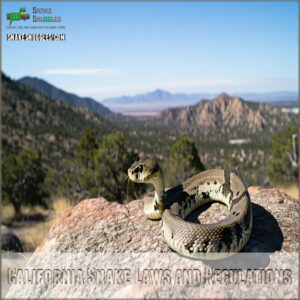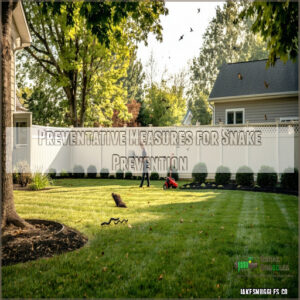This site is supported by our readers. We may earn a commission, at no cost to you, if you purchase through links.
 The law on killing snakes varies by state, so you’ll need to know your local rules to avoid hefty fines—or worse.
The law on killing snakes varies by state, so you’ll need to know your local rules to avoid hefty fines—or worse.
In Alabama, you can’t kill native snakes without a permit. California lets you remove a snake threatening your safety or property but requires a license for other situations. Arkansas allows it only if the snake poses an immediate threat, while Mississippi has strict protections for native species.
Many laws focus on conservation, protecting ecosystems and biodiversity. So, before you panic over a slithery intruder, know the law—it’s better than explaining to a judge why you acted too quickly, considering the potential for hefty fines.
Table Of Contents
- Key Takeaways
- Snake Protection Laws by State
- Penalties for Killing Protected Snakes
- Exceptions and Considerations for Snake Killing
- Snake Conservation and Importance
- Snake Safety Tips and Encounter Response
- Legal Status of Snake Handling by State
- States Where Pet Snakes Are Illegal
- Additional Ownership Considerations
- Native and Exotic Venomous Snakes Regulations
- Frequently Asked Questions (FAQs)
- Is it illegal to kill a snake?
- Are snake laws complicated?
- What laws stop people from killing snakes?
- Is it illegal to kill snakes in Virginia?
- Is it illegal to kill a snake in Texas?
- Is it illegal to kill snakes in Rhode Island?
- What state is it illegal to kill snakes?
- Can you kill a snake on your property?
- Why is it illegal to kill snakes in Tennessee?
- Why is it illegal to kill snakes in Virginia?
- Conclusion
Key Takeaways
- You’ll need permits to kill snakes in most states, with exceptions only for immediate threats to safety or property – states like Alabama, California, and Arkansas have strict regulations with fines up to $500 for illegal killing.
- You can face federal penalties up to $50,000 and jail time for killing protected snake species, so it’s crucial to correctly identify the snake before taking any action.
- You’re better off using prevention methods like sealing entry points, removing food sources, and keeping your yard clean rather than killing snakes, as they help control pest populations and maintain ecosystem balance.
- You’ll find the most lenient snake laws in Texas where you can kill non-protected snakes, while states like Maryland and Georgia have complete bans on snake killing unless there’s an immediate threat to human life.
Snake Protection Laws by State
Snake protection laws vary widely across states, with some offering strict safeguards and others allowing exceptions for safety.
Knowing your state’s rules can help you avoid hefty penalties and stay on the right side of the law.
Alabama Snake Laws and Regulations
In Alabama, snake laws are strict, especially for native species.
You’ll need permits for dealing with protected snakes, including the Eastern Indigo.
Venomous species like the Eastern Diamondback also require careful handling.
Hunting rules and fines up to $500 apply for illegal killing.
Protected areas prioritize conservation, so following Alabama’s snake regulations is vital.
Remember these key points:
- Permits are required.
- Venom species need extra care.
- Most snakes are protected.
- Fines are steep.
- Missteps aren’t cheap!
Before handling any species, it’s important to check reptile regulations to ensure you are aware of the protected species and can avoid steep fines.
Alaska Snake Laws and Regulations
Alaska’s snake laws are strict, prioritizing ecosystem safety. All snakes are non-native, so import and possession require permits. Venomous snakes? Permits are for educational purposes only, no personal pets allowed.
Always review snake laws by state for compliance. For more information on reptile ownership, check the reptile laws to confirm you’re aware of the regulations.
| Category | Rule | Example |
|---|---|---|
| Import Restrictions | Permit required | Prevents invasive threats |
| Nonvenomous Rules | Check “Clean List” | Approved species only |
| Venomous Snake Laws | Educational-only permits | Bans personal venomous pets |
Arizona Snake Laws and Regulations
Mastering Arizona’s snake laws is key to staying on the right side of the law.
Killing rattlesnakes in Arizona is legal for most species with a permit, but protected venomous species—like Ridge-nosed or Massasauga rattlesnakes—are off-limits.
These Arizona regulations require caution. Violating venomous snake laws can mean hefty penalties, so always check Rattlesnake laws.
Snake permits are sometimes necessary.
Arkansas Snake Laws and Regulations
Snake laws in Arkansas allow killing only if a snake poses an immediate threat to you, pets, or property.
Exotic ownership is restricted, and venomous snakes require permits.
Misidentification risks violating Arkansas snake killing laws, so call relocation services for safety. Conservation is key, as Arkansas law against killing snakes underscores their ecological role in pest control.
California Snake Laws and Regulations
California snake laws emphasize conservation. Killing snakes is illegal without a valid sport fishing license, except for self-defense or property threats.
Protected species, like rattlesnakes, require Snake Permits. California fines are steep for violations under the California snake ban.
Reptile laws restrict native species possession, ensuring balance. Properly identify snakes before acting; venomous laws, unlike Arizona’s, are strictly enforced.
Specific State Laws for Snake Killing
Each state’s snake killing laws differ, so know the rules!
- Arkansas: Permits snake killing only for defense; all other killings violate state snake regulations.
- Mississippi: Native snakes are strictly protected under Protection Acts.
- California: Most species require killing permits, following the state’s ban exceptions.
- Detroit, Michigan: Recent venomous snake laws (2023) impose fines for illegal harm.
Stay informed before acting!
State-Specific Penalties for Snake Killing
Penalties for breaking state snake regulations hit hard.
Violators face stiff killing fines, jail terms, or both. Here’s a snapshot:
- Tennessee: Harm native snakes? Legal consequences include fines or arrest.
- Georgia: Snake killing laws list $1,000 penalty fees or a year in jail.
- Virginia: Class 2 misdemeanor—expect legal consequences!
- Wisconsin: Protected herptiles? Watch for steep fines imposed.
- South Carolina: Public land violations bring fines and potential 30-day jail terms!
Exceptions to State Snake Protection Laws
Understanding exceptions to state snake laws is key.
Invasive species? You’re usually fine removing them.
Snakes on your property? Action’s allowed if they’re a threat, but only non-protected types.
Endangered or federally protected species? Hands off—no exceptions.
Know your state snake protection laws and identify species to avoid hefty fines or legal trouble.
Missteps can cost you, so it’s crucial to understand the laws and follow them to avoid any legal trouble and ensure you’re not removing a federally protected species.
Penalties for Killing Protected Snakes
If you kill a protected snake, you could face significant fines or even jail time depending on the laws in your state.
These penalties are designed to enforce wildlife protection rules and prevent harm to endangered species.
Fines for Killing Venomous Snakes
Killing venomous snakes like rattlesnakes or copperheads can be expensive, especially under venomous snake laws.
In Georgia, the penalty for killing a rattlesnake can reach $1,000. Even if you think it’s dangerous, misidentifications can lead to hefty fines.
Here are key points about Venomous Snake Fines:
- Misidentifying a venomous species risks fines.
- Killing protected rattlesnakes violates state laws.
- Killing Penalties vary nationwide.
- Focus on Snake Conservation and rely on wildlife protection services.
Understanding state laws is essential for snake owners and the general public.
Jail Time for Killing Endangered Snakes
Taking an endangered species’ life isn’t just breaking the law—it’s a wildlife crime with serious consequences.
Harming a federally protected snake, like a rattlesnake, can bring up to a year in jail under federal laws regarding venomous snakes.
Misidentifying a non-threat as “illegal” could still land you in trouble.
The punishment for killing protected rattlesnakes reinforces the importance of snake conservation.
So, before acting, know the laws and avoid facing hefty fines or jail sentences.
Federal Penalties for Killing Protected Snakes
Federal laws regarding venomous snakes and protected species mean serious business.
Under the Endangered Species Act, killing fines or penalty fees for harming protected snake species, like the timber rattlesnake federally protected, can hit $50,000 or land you in jail for a year.
These federal fines get your attention fast!
So, before acting, identify the snake carefully—mistakes can cost you big under federal law against killing rattlesnakes or others.
Misidentification Consequences
Mistaking a protected snake species for a common one isn’t just an oops—it’s a legal nightmare.
Whether it’s federal law against killing rattlesnakes or state wildlife regulations, Snake Misid can result in:
- Fines up to $25,000 per Wrong Kill
- Jail time of up to a year
- Hunt/Fish permit revocation
- Sky-high legal fees
- Reputation damage.
Fatal errors in snake identification don’t just hurt conservation—they hurt your wallet and freedom.
When in doubt, let it slither away safely!
Exceptions and Considerations for Snake Killing
Sometimes, killing a snake is legally allowed if it’s necessary to protect yourself, others, or your property. Knowing when these exceptions apply helps you stay safe while following the law.
Self-Defense and Property Protection
Knowing when you can legally act against a snake is essential for protecting yourself and your home.
Snake attacks or threats can happen unexpectedly, and laws for killing snakes are strict. Most states allow using deadly force for self-protection or home defense, especially if a venomous snake endangers your family, pets, or property.
However, snake removal laws often require careful judgment to avoid penalties.
| For clarity, here’s a quick guide: | Situation | Legal Action | Advice |
|---|---|---|---|
| Venomous on property | Allowed in many states | Contact wildlife control | |
| Non-venomous and harmless | Often illegal | Safely relocate | |
| Threat to pets | Permitted in emergencies | Use caution | |
| Protected species | Illegal | Don’t engage; seek help | |
| No immediate threat | Likely illegal | Use deterrents |
Understand local snake killing laws and always prioritize safe removal practices.
Remember, ignorance of the law won’t protect you from fines.
Snake Hunting for Skins, Meat, or Control
Hunting snakes for skins, meat, or population control is legal in some areas, but strict rules apply.
Always check snake hunting regulations before proceeding.
Stay within legal boundaries by ensuring:
- You’ve got the right hunting license for your state.
- Target only allowed species and respect venomous snake laws.
- Follow snake culling laws for invasive species.
- Use safe, legal methods.
- Understand rules for transporting venomous snakes.
By sticking to these guidelines, you’ll contribute to conservation efforts while staying on the right side of the law!
Professional Snake Relocation and Removal
Snake removal isn’t a DIY project.
Professionals follow snake removal regulations, maintaining safety, legality, and compliance with snake relocation laws.
Equipped with permits and expertise in snake mitigation, they’re trained in safe venomous handling and humane relocation methods.
When laws on killing snakes by state prohibit harm, these experts offer solutions that protect you and the snake.
Let wildlife control handle the scales—it’s worth it! Effective snake removal requires knowledge of snake removal services to achieve safe and legal relocation.
Importance of Correct Snake Identification
Getting the right Snake ID Tips is essential for both safety and following snake identification laws.
Misidentifying a nonvenomous snake as a venomous species might lead to legal trouble, especially with protected species.
Learn key Reptile Classification skills, like spotting color patterns or head shapes, to avoid fines for harming the wrong snake.
Correct Species Recognition helps keep you safe and supports Wildlife Conservation, ensuring these critical snake species thrive in their ecosystems.
Ethical Concerns for Snake Killing
Killing snakes raises moral implications and questions about conservation ethics and animal rights.
Instead of harming them, safeguard your home humanely:
- Seal entry points to block snake access.
- Remove food sources attracting them, like rodents or waste.
- Relocate safely when snakes pose no threat.
- Educate your community on snake welfare and venomous snake laws.
Awareness promotes safety while respecting punishment for killing an illegal species, like under Snake killing laws in Arkansas.
Snake Conservation and Importance
Snakes play an essential role in keeping ecosystems balanced by controlling pests and supporting biodiversity. Understanding their importance helps you appreciate why many laws protect them and promote conservation.
Snakes Role in Ecosystem Balance
Snakes play an essential role in the ecosystem balance, acting as natural pest control by reducing overpopulated rodents and maintaining biodiversity.
Their presence strengthens food chains and supports habitat preservation, ensuring other species thrive.
Following snake regulations by state safeguards these unsung heroes, whose survival is critical for snake conservation and wildlife conservation efforts, protecting both endangered species and overall ecosystem health.
Population Control and Disease Prevention
Picture snakes as your garden’s stealthy exterminators. They quietly manage rodent populations, reducing pests that spread diseases like hantavirus or Lyme disease.
Without them, you’d likely see an uptick in health risks and crop damage. Snakes are also guardians of eco health, maintaining wildlife balance and healthy population dynamics.
Snakes aren’t just predators—they’re a bridge in the food web, supporting creatures that prey on them. Protecting snakes under wildlife laws maintains a stable ecosystem for everyone’s benefit.
- Control disease-carrying rodents
- Help prevent crop infestations naturally
- Support wildlife balance and biodiversity
- Reflect eco health through stable population dynamics
Snake management starts with awareness, not fear!
Food Chain Importance and Biodiversity
Eliminating snakes disrupts ecosystem balance, leading to pest surges. They’re nature’s pest control, managing rodents and other small animals that can harm crops or spread disease.
Snakes play an essential part in biodiversity conservation and food chains, maintaining species preservation.
| Role | Impact | Importance |
|---|---|---|
| Rodent Control | Reduces crop damage | Helps farmers, sustains food |
| Predator-Prey | Balances populations | Prevents overpopulation damage |
| Biodiversity Boost | Supports ecosystems | Protects endangered species |
The role of snakes in ecosystem balance is crucial, and their elimination can have severe consequences, including the surge of pests that can damage crops and spread disease, highlighting the importance of nature’s pest control.
Habitat Preservation and Snake Survival
Healthy habitats mean thriving snakes.
Habitat loss leads to species decline and disrupts ecosystem balance.
You can support wildlife preservation by taking small steps:
- Restore habitats by planting native plants or removing invasive species.
- Avoid pesticides that harm ecosystems and snake populations.
- Support community efforts focusing on habitat preservation and snake protection.
Protecting ecosystems benefits endangered species and maintains future balance.
Education and Awareness for Snake Conservation
Understanding snake habitat loss fosters wildlife preservation and eco education.
Conservation efforts reveal truths about venomous and nonvenomous snake laws, helping you follow state laws on killing snakes.
Embrace species research—join conservation projects and spread awareness.
| Myth | Truth | Action |
|---|---|---|
| All snakes are dangerous. | Most are nonvenomous! | Learn to identify them. |
| Snakes attack unprovoked. | They mostly avoid humans. | Observe from a distance. |
| Snakes harm the ecosystem. | They balance populations. | Support snake conservation. |
Snake Safety Tips and Encounter Response
When you encounter a snake, staying calm and keeping your distance is essential for safety.
Understanding simple prevention tips can help you avoid unnecessary risks while protecting yourself, your family, and the snake.
Avoiding Confrontation and Prioritizing Safety
Regarding snake safety, focus on minimizing risks during wild encounters.
Follow these defensive measures:
- Stay Calm: Sudden moves can provoke snakes—step back slowly.
- Look Closely: Learn to spot venomous and nonvenomous traits.
- Stick to Trails: Avoid tall grass or hidden spots.
- Emergency Response: For venomous bites, never delay calling 911.
Respect snake laws and stay safe outdoors!
Using Water Hose to Deter Snakes
If you spot a snake, grab your garden hose—it’s a safe way to guide them out.
Use a steady, gentle stream of cool water to nudge it along without harm.
Avoid high-pressure blasts; you’re not washing a car.
Stand back to keep your distance, ensuring everyone stays safe.
This humane snake deterrent respects snake behavior while keeping your property harmlessly snake-free.
Always follow state laws about snake deterrents and killing snakes legally.
For effective snake deterrence, consider using the right garden hose nozzles to control water pressure.
Protecting Children and Pets From Snakes
Protecting children and pets from snakes starts at home with simple Snake Safety Tips.
Build a snake-proof yard by keeping it tidy:
- Trim shrubs and remove junk piles.
- Educate children to respect, not fear, snakes.
- Leash pets during walks to avoid encounters.
- Know venomous snake laws before handling risks.
Understanding snake health basics is essential for effective snake-proofing measures.
Snake-proofing safeguards loved ones while respecting killing snakes legally.
Observing From a Distance and Contacting Wildlife Control
Keep your cool when you spot a snake, whether it’s venomous or not.
Maintain safe distance observation and don’t try to touch or identify it yourself.
Call wildlife control for professional animal removal—they understand local snake laws and handle emergencies safely.
Remember, even nonvenomous snakes can bite.
Always follow snake permit requirements to handle situations legally.
Stay safe!
Preventative Measures for Snake Prevention
To reduce snake encounters, focus on prevention.
- Install snake-proof fencing to block their path.
- Prioritize yard cleanup by removing debris where snakes may hide.
- Seal entry points around your home to stop sneaky intruders.
- Eliminate food sources like rodents—they attract snakes faster than free lunch.
Effective snake proof fencing is essential for safety.
Know your local snake laws to avoid violating regulations accidentally.
Legal Status of Snake Handling by State
Regarding snake handling, state laws vary widely, and the rules can be surprisingly strict. Understanding what’s legal in your area is essential to avoid hefty fines or other penalties.
Permit Requirements for Snake Handling
Thinking of handling snakes? Many states require snake permits or wildlife certificates, especially for venomous or exotic species.
For example, Texas mandates handling licenses for non-native venomous snakes. Regulations often cover educational or scientific uses.
Always check local wildlife agencies for specific venomous snake laws and importing rules. Ignoring permits could lead to hefty fines or worse—steep legal trouble!
Species Limitations for Snake Handling
Snake handling laws vary across states, especially for venomous species and protected snakes.
Some states completely ban exotic ownership, while others allow it with strict permits.
Here’s what you need to know:
- Permits: Most states require permits for handling venomous species or species protected by state laws.
- Training: Completing approved snake handling training is often required.
- Exotic Ownership: Many states limit or ban exotic snakes to protect ecosystems.
- Transport: Laws for transporting venomous snakes are strict, focusing on public safety and native conservation.
Always check local rules before handling or owning snakes.
Prohibited Animals for Handling
Handling exotic animals like venomous snakes, wild snakes, or protected reptiles is heavily restricted by venomous snake laws across states.
These laws safeguard public health and biodiversity. Animals on endangered lists or federally protected classes, such as rattlesnakes, often require permits for transport.
Selling rattlesnake skin? That’s likely illegal. States prioritize safety over personal preferences for exotic ownership.
Compliance Standards for Snake Handling
Snake handling laws vary widely, focusing on safety and conservation.
Permits are mandatory for venomous snakes or endangered species. States emphasize wildlife safety through strict rules:
- Prohibit killing snakes without permits or immediate danger.
- Require ethical practices for handling venomous snakes.
- Mandate permits for nonvenomous species in certain states.
Ignoring snake regulations can lead to fines or jail time.
States Where Pet Snakes Are Illegal
Some states completely ban pet snakes, focusing on public safety and environmental concerns. Knowing your state’s rules will help you avoid fines or legal trouble.
Alabama Laws for Pet Snakes
In Alabama, owning venomous species not found in the wild, except hognose snakes, is illegal without permits.
Permits regulate snake ownership for native and non-native reptiles. Violating reptile laws can lead to fines.
Since 2001, exotic venomous reptiles are banned for pet safety.
| Criteria | Allowed | Banned | Exceptions |
|---|---|---|---|
| Native Snakes | Permitted | None | Hognose only |
| Non-Native Venomous | Permit Needed | Illegal | None |
| Snake Safety Compliance | Essential | Fines for Violations | None |
| Special Exhibitions | Permits Only | Without Documentation | None |
Alaska Laws for Pet Snakes
Alaska’s strict wildlife laws don’t leave room for pet snake ownership. Exotic species, including snakes, are banned due to ecological risks.
Want a snake? Here’s what to know:
- No exotic snakes allowed—period.
- Permits required for non-native reptiles.
- Veterinary inspections needed pre-import.
- Wild forest snakes can’t be killed.
- Violating wildlife laws leads to steep fines.
Arizona Laws for Pet Snakes
If you’re considering snake ownership in Arizona, it’s essential to follow the state’s strict reptile laws.
Venomous species often require permits, and pet restrictions apply to native and exotic snakes. Killing rattlesnakes in Arizona laws allow only justified actions. Violate Arizona laws for pet snakes, and penalties follow.
Here’s a quick breakdown:
| Requirement | Details | Example |
|---|---|---|
| Permit Needed? | Yes | Venomous species like cobras |
| Restricted Species | Exotic and native venomous snakes | Western Diamondback Rattlesnake |
| Permit Exceptions | Educational purposes only | Schools, science centers |
| Penalty for Violations | Fines and legal action | Illegal ownership or killing |
| Relocation Rules | Professional removal required | Federally protected species |
Arkansas Laws for Pet Snakes
Arkansas allows Snake Ownership of many non-prohibited species without permits, but non-native or Venomous Species may need compliance checks.
For Pet Regulations, the Arkansas Game and Fish Commission requires permits for breeding and imports.
Curious about are snakes protected in Arkansas? While relocation guidelines exist, local laws vary.
Catching native snakes? Check Arkansas law for catching snakes to avoid violating Exotic Laws or disturbing protected species, and note that relocation guidelines are in place.
California Laws for Pet Snakes
California enforces strict snake ownership regulations, particularly for venomous snakes. Owning species like rattlesnakes or cobras is prohibited without proper reptile permits, which are rarely granted.
Exotic animal laws forbid dangerous reptiles, ensuring public safety. Pet regulations also cover non-domestic snakes, requiring compliance with California laws.
If you’re considering pet ownership here, double-check local guidelines to avoid hefty fines for improper handling.
Additional Ownership Considerations
When owning a pet snake, you’ll need to understand the potential legal and financial risks involved.
Ensuring you meet compliance standards and provide proper care isn’t just essential—it’s the law.
Ownership Risks for Pet Snakes
Owning a pet snake comes with unique risks that might slither into your daily life.
Here’s what to examine:
- Escape Risks: Poor housing could result in Snake Escapes.
- Venomous Bites: Medical emergencies can occur with venomous species.
- Liability Costs: You may face financial fallout for accidents.
- Exotic Permits: Regulations vary under exotic animal laws.
- Public Perception: Fearful neighbors might complicate matters.
Proper snake enclosure setup is essential for responsible pet ownership.
Insurance Coverage for Pet Snakes
Pet snake policies, like reptile insurance, help protect you financially while assuring your slithery companion gets proper care.
Exotic pet coverage can include vet bills and liability insurance—essential for venomous snake premiums.
With plans starting under $10/month, it eases liability concerns tied to exotic pet laws or snake possession limits.
Responsible ownership meets affordability—a win-win for snake owners with exotic pet coverage and reptile insurance!
Compliance Standards for Pet Snakes
Owning a pet snake? You’ll need to follow strict pet snake laws by state. These include permit requirements and snake licensing for certain species.
Stay compliant with these guidelines:
- Housing: Secure enclosures that meet safety standards.
- Health certificates: Regular vet care maintains your snake’s health.
- Registration: Specific states require snake registration.
- Owner liability: Liability insurance may be essential, especially for venomous snakes.
- Limits on possession: Some states enforce caps on snake numbers.
Compliance avoids fines and keeps everyone safe!
Specialized Care for Pet Snakes
If you’re thinking of owning a snake, start with proper habitat design—secure, heated, and escape-proof.
Add UVB lighting, hiding spots, and regular snake feeding.
Keep snake health exceptional with vet check-ups and safe pet handling.
Venomous care isn’t for beginners, and remember, pet snake laws by state vary widely.
Know snake legislation and avoid violating laws on killing snakes!
Native and Exotic Venomous Snakes Regulations
State laws for venomous snakes often vary depending on whether a species is native or exotic. Knowing these rules helps you navigate protections, restrictions, and potential penalties.
Alabama Native Venomous Snakes Overview
Alabama is home to six venomous snakes, including Copperheads, Eastern Diamondback Rattlesnakes, and Eastern Coral Snakes.
Understanding their habitats, behaviors, and venom types is essential for safety.
It’s against the law to kill snakes protected by Alabama laws. These regulations aim to conserve at-risk species, so always verify if rattlesnakes are protected before acting.
Respect conservation efforts!
Arizona Native Venomous Snakes Overview
Arizona’s harsh deserts host fascinating but dangerous species like Rock, Twin Spotted, and Ridgenosed Rattlesnakes.
Snake conservation is key under state law, while killing snakes is against the law for protected species, knowing their habits maintains safety.
Arizona laws killing snakes without proof of threat can lead to penalties, and Rattlesnake habits and venomous bites demand caution—observe from a safe distance, respect regulations, and always prioritize desert safety.
Arkansas Native Venomous Snakes Overview
Arkansas boasts six venomous species like copperheads, timber rattlesnakes, and cottonmouths.
Snake Habitat matters—timber rattlesnakes love forests! Per Arkansas law for catching snakes, protected species can’t be harmed unless threatening humans.
Spot these traits:
- Copperhead: Peach skin, hourglass markings.
- Cottonmouth: White lip, dark crossbands.
- Timber Rattlesnake: Rusty back stripe.
Remember, Conservation Efforts keep ecosystems healthy. Are rattlesnakes protected in Mississippi? Yes; check state rules.
California Native Venomous Snakes Overview
California’s venomous snake laws protect species like the Pacific rattlesnake and western diamondback.
Permits are required for possession under wildlife regulations. While albino snakes may be exempt, killing protected species invites penalties.
Here’s a quick breakdown:
| Snake | Habitat | Conservation Status | Bite Symptoms | Venom Type |
|---|---|---|---|---|
| Pacific Rattlesnake | Forests | Threatened | Swelling, pain | Hemotoxic |
| Western Diamondback | Deserts | Stable | Tissue damage | Hemotoxic |
| Mojave Rattlesnake | Deserts | Threatened | Neurological impacts | Neurotoxic |
| Red Diamondbacks | Rocky regions | Endangered | Severe pain, nausea | Hemotoxic |
| Southern Pacific Rattler | Grasslands | Stable | Blood clotting disruption | Hemotoxic |
Exotic Venomous Snakes Restrictions
Owning an exotic venomous snake can be quite the challenge, thanks to varying venomous snake laws.
Many states have tight rules to keep exotic species under control.
- Snake permits are essential: Exotic animals like cobras or vipers usually require hard-to-get permits. Research your state’s reptile laws.
- Prohibited snake species: Some snake species, labeled as protected species, are outright banned. Federal laws may step in, too.
- Think venom control: Even if legal, responsible care, including secure enclosures, is essential to prevent escape or harm.
Do your homework—venomous snakes demand legal compliance and serious responsibility.
Frequently Asked Questions (FAQs)
Is it illegal to kill a snake?
Killing snakes might seem like taking control, but it’s often illegal, with steep fines or jail time.
Laws vary by state, so know your local rules.
Federally protected species bring serious penalties. Always check first!
Are snake laws complicated?
Snake laws can feel like a maze—rules vary by state, species, and even situation.
Some states protect all snakes, others focus on specific ones.
Knowing the laws keeps you safe and legally sound!
What laws stop people from killing snakes?
Imagine a shield protecting snakes nationwide—that’s the Endangered Species Act.
It prohibits killing protected species, with hefty fines and jail time.
Many states add laws, safeguarding specific snakes and balancing conservation with public safety.
Is it illegal to kill snakes in Virginia?
In Virginia, it’s illegal to kill any snake protected by federal or state laws, like the Eastern Ratsnake or Timber Rattlesnake.
Always check specific protections before acting to avoid fines or penalties.
Is it illegal to kill a snake in Texas?
In Texas, it’s legal to kill non-protected snakes, but you can’t harm threatened or endangered species like the Louisiana pine snake.
Always confirm local laws and remember, some harmless snakes are great for pest control!
Is it illegal to kill snakes in Rhode Island?
In Rhode Island, killing snakes is prohibited without a valid reason.
The state protects all native snakes, prioritizing coexistence over harm.
So, it’s better to admire them from a safe distance!
What state is it illegal to kill snakes?
You can’t legally kill snakes in Maryland and Georgia – it’s completely banned.
Arkansas protects all snakes unless they’re threatening you, while Iowa safeguards most species except gartersnakes in specific counties.
Can you kill a snake on your property?
Powerful property protection permits you to kill snakes if they’re threatening people or pets.
You can’t kill protected species though – you’ll need to check your state’s specific laws first to avoid penalties.
Why is it illegal to kill snakes in Tennessee?
You can’t kill snakes in Tennessee because state law protects all native snakes as nongame wildlife.
You’ll face fines if you harm them, unless they’re posing an immediate threat to people or property.
Why is it illegal to kill snakes in Virginia?
You can’t harm snakes in Virginia since they’re essential for the ecosystem’s balance.
The state’s wildlife laws protect all native snake species, and you’ll face penalties if you deliberately kill them.
Conclusion
As they say, "An ounce of prevention is worth a pound of cure."
Before taking action against a snake, you’ll want to understand the law on killing snakes by state. Each jurisdiction has its own rules, exceptions, and penalties.
Learn your local regulations, keep wildlife control numbers handy, and remember that most snakes play essential roles in our ecosystem.
You’re now equipped to handle snake encounters legally and safely—whether you’re in Mississippi or Montana.
- https://dscnortheast.org/the-states-where-its-illegal-to-kill-snakes/
- https://x.com/MarylandDNR/status/1417094656974721026
- https://www.wtvr.com/podcast/2019/05/09/snakes-are-popping-up-across-virginia-but-heres-why-killing-them-is-illegal
- https://www.quora.com/Is-it-safe-to-kill-a-snake-in-the-USA
- https://www.wideopenspaces.com/the-states-where-its-illegal-to-kill-snakes/


























